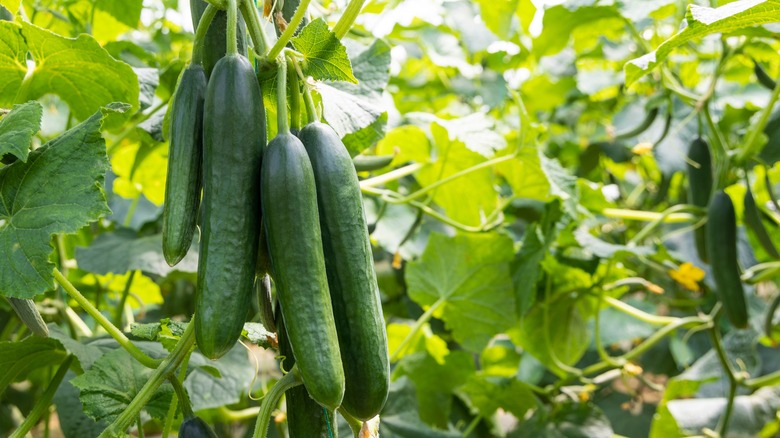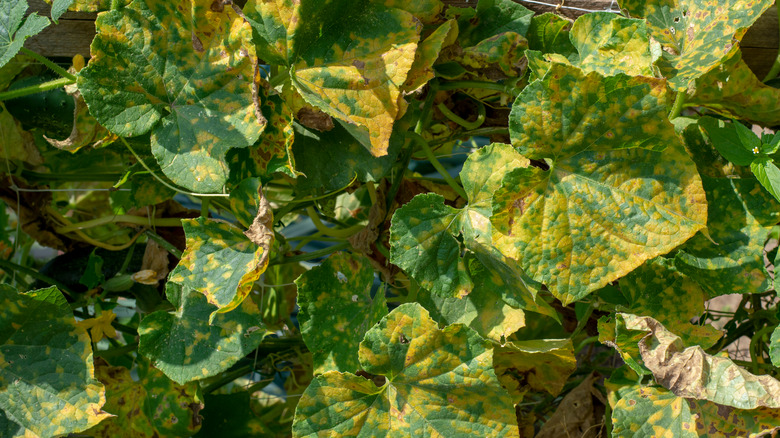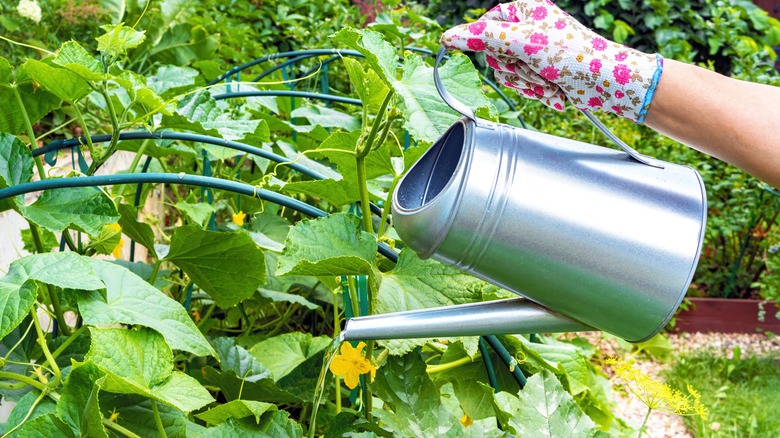What's The Best Way To Treat Downy Mildew On Cucumbers?
Gluttony may be a sin, but a surplus in the garden is a welcome headache for all vegetable growers. Gardeners know that late summer and early fall harvests can get out of control quickly, and, if you're doing things right, they can produce far more food than you can eat. An age old solution to overabundance, per House & Garden, is pickling your produce so it lasts longer — and which vegetable is the king of the pickles? In America, it's the cucumber.
Cucumbers are part of the cucurbit family of plants, along with zucchini and squashes. They grow on vines, and the reason they're so popular for pickling is that they tend to be vigorous growers and prolific producers, according to the Old Farmer's Almanac. In order to fuel all of that fruit production, cucurbit plants need 6 to 8 hours of sunlight a day, and they love the heat of summer. Cucumbers themselves are very high in water content, and it's important to keep your plants well hydrated as they grow. However, conditions that are warm, with plenty of moisture can also encourage the wrong kind of growth in the form of unwanted pests and fungal diseases that can turn your autumnal glut into a total bust. So, it's important to understand the environmental conditions that could crash your cucumber party. In particular, here's what to look out for regarding downy mildew.
How to tell if your cucumber plants have downy mildew
Pseudoperonospora cubensis is the scientific name for the water mold that causes downy mildew on cucumber plants, according to the Ontario Ministry of Agriculture, Food, and Rural Affairs. It can impact other vegetables in the cucurbit family, but cucumbers are the most susceptible to downy mildew infections. The first sign of this disease will be small yellow spots or lesions on the topsides of older leaves. As they grow they can take on a slightly oily or greasy appearance. As the infection progresses and the spots get bigger, their progress is hampered by plant veins, which gives their shape a bit of an angled effect.
The word downy refers to the dark purple to black colored growth splotches of sporangia that begin to appear on the underside of the leaves, opposite the yellow spots. These downy growths can be seen with a magnifying glass and occur in conditions that are particularly humid, such as after early morning dew or rainfall, explains University of Missouri. Eventually, as the disease takes over the plant, the lesions can group together and turn large areas of affected leaves necrotic. Left unchecked, this will kill the entire leaf or plant. The most favorable environmental conditions for downy mildew to take hold are moist and cool. According to NC State Extension, 6 to 12 hours of moisture along with temperatures that hover around 60 degrees Fahrenheit represent the danger zone for infection.
How to get rid of downy mildew on cucumber plants
The best way to deal with a plant disease is to avoid infection entirely, and a sensible starting point is to plant mildew-resistant varieties. According to University of Illinois Extension, commercial cucumber varieties have been bred for increased levels of resistance. Cucumber plants need a lot of space so that there's ample airflow around the leaves. Remember that downy mildew likes high levels of moisture, so everything we can do to speed up the drying of leaves will help keep the plants safe. Similarly, spraying the leaves with water every day is akin to inviting mildew to move in and get comfortable. Instead, water the roots and soil as gently and directly as possible.
Each year the spores that result in a downy mildew infection gradually move northward, from field to field on the wind and weather. There's a project that forecasts the seasonal progress of downy mildew for all cucurbits, and you can sign up to be alerted if the pathogen has been reported in your area through Integrated Pest Management. If you know it's in the air, then you'll want to be particularly vigilant about leaf moisture. Per NC State Extension, most chemicals available to home gardeners aren't strong enough to control downy mildew once it's taken hold. If you really want to try treating with fungicides, look for products with the active ingredients of copper or chlorothalonil — but you are best advised to remove the plants instead.


